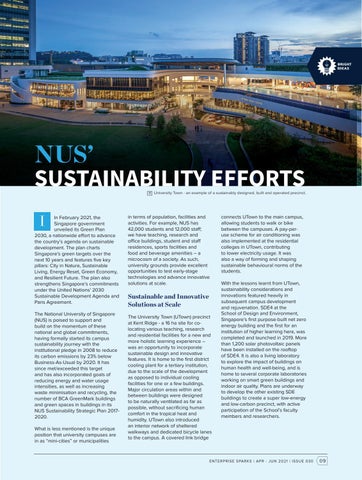NUS’ SUSTAINABILITY EFFORTS
University Town - an example of a sustainably designed, built and operated precinct.
I
In February 2021, the Singapore government unveiled its Green Plan 2030, a nationwide effort to advance the country’s agenda on sustainable development. The plan charts Singapore’s green targets over the next 10 years and features five key pillars: City in Nature, Sustainable Living, Energy Reset, Green Economy, and Resilient Future. The plan also strengthens Singapore’s commitments under the United Nations’ 2030 Sustainable Development Agenda and Paris Agreement. The National University of Singapore (NUS) is poised to support and build on the momentum of these national and global commitments, having formally started its campus sustainability journey with the institutional pledge in 2008 to reduce its carbon emissions by 23% below Business-As-Usual by 2020. It has since met/exceeded this target and has also incorporated goals of reducing energy and water usage intensities, as well as increasing waste minimisation and recycling, the number of BCA GreenMark buildings and green spaces in buildings in its NUS Sustainability Strategic Plan 20172020. What is less mentioned is the unique position that university campuses are in as “mini-cities” or municipalities
in terms of population, facilities and activities. For example, NUS has 42,000 students and 12,000 staff; we have teaching, research and office buildings, student and staff residences, sports facilities and food and beverage amenities – a microcosm of a society. As such, university grounds provide excellent opportunities to test early-stage technologies and advance innovative solutions at scale.
Sustainable and Innovative Solutions at Scale The University Town (UTown) precinct at Kent Ridge - a 16 ha site for colocating various teaching, research and residential facilities for a new and more holistic learning experience – was an opportunity to incorporate sustainable design and innovative features. It is home to the first district cooling plant for a tertiary institution, due to the scale of the development as opposed to individual cooling facilities for one or a few buildings. Major circulation areas within and between buildings were designed to be naturally ventilated as far as possible, without sacrificing human comfort in the tropical heat and humidity. UTown also introduced an interior network of sheltered walkways and dedicated bicycle lanes to the campus. A covered link bridge
connects UTown to the main campus, allowing students to walk or bike between the campuses. A pay-peruse scheme for air conditioning was also implemented at the residential colleges in UTown, contributing to lower electricity usage. It was also a way of forming and shaping sustainable behavioural norms of the students. With the lessons learnt from UTown, sustainability considerations and innovations featured heavily in subsequent campus development and rejuvenation. SDE4 at the School of Design and Environment, Singapore’s first purpose-built net zero energy building and the first for an institution of higher learning here, was completed and launched in 2019. More than 1,200 solar photovoltaic panels have been installed on the rooftop of SDE4. It is also a living laboratory to explore the impact of buildings on human health and well-being, and is home to several corporate laboratories working on smart green buildings and indoor air quality. Plans are underway to develop the other existing SDE buildings to create a super low-energy and low-carbon precinct, with active participation of the School’s faculty members and researchers.
EN T ERP RI SE SPA RKS | A P R - J UN 2021 | I SSUE 0 30
09













